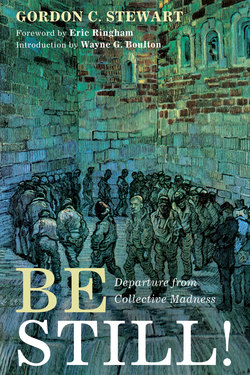Читать книгу Be Still! - Gordon C. Stewart - Страница 7
На сайте Литреса книга снята с продажи.
Preface
ОглавлениеI invite you to look at this collection as a kind of photo album. Each snapshot focuses on a singular moment in real time.
Like the times on which these essays focus, the author’s lens is set in time. It developed from the experiences of faith and doubt, hope and despair, sanity and madness, solitude and loneliness, stillness and frenzy, companionship and forlornness. I alternate between the quiet calm of the psalmist—“Be still, and know that I am God” (Ps 46)—and deep disquiet over the madness that fills the news, and me.
Throughout it all, my camera lens looks as much for what is left unsaid as for what’s said. Willem Zuurdeeg’s and Esther Swenson’s work in analytical philosophy of religion taught me to look and listen for the governing convictions a speaker takes for granted, the bedrock underpinnings upon which a speaker depends. To be human is to die. And to die is to live with what Rudolf Otto called the mysterium tremendum et fascinans, the larger mystery that both causes us to tremble and that draws us irresistibly, the whence and whither of existence itself.
Elie Wiesel and Walter Brueggemann challenge the collective madness that often passes for sanity. But their insights into the depths of collective madness are anchored in the deep stillness of Psalm 46. Kosuke Koyama, to whom this book is dedicated, knew collective madness as a youth in Japan and again in his adopted home in the United States. Over lunch one day, he made a statement that added to how I look at the world. “There’s only one sin,” he said. “Exceptionalism.” I’ve been thinking about that ever since in relation to the manifold ways in which this one sin manifests itself: religion, race, nation, gender, culture, and, finally, species exceptionalism.
Perhaps a picture of a moment in time with Kosuke will whet your appetite.
The day I’m remembering, Koyama was scheduled to deliver the inaugural address for a new speaker series in Chaska, a forty-minute drive from his home in downtown Minneapolis. Shortly after we left his apartment, the car broke down on the entrance ramp to the interstate. It just quit! Neither one of us had a phone. While I ran back to get help, frantic because we were going to be late, Ko stayed with the car. I had forgotten what Ko had written in Three Mile an Hour God:
We lead today an efficient and speedy life. . . . There is great value in efficiency and speed. But let me make one observation. I find that God goes “slowly” in [God’s] educational process. . . . “Forty Years in the Wilderness” points to [God’s] basic educational philosophy. . . . God walks slowly because [God] is love.1
When the mechanic and I returned to the car, Ko was sitting in the passenger seat like the Buddha himself—calm, cool, and collected. I asked whether he was OK. He smiled and said, “Good meditation.”
I hope in some way the still shots of Be Still! Departure from Collective Madness offer you an opportunity or two for a “good meditation.”
1. Koyama, Three Mile an Hour God, 6–7.
